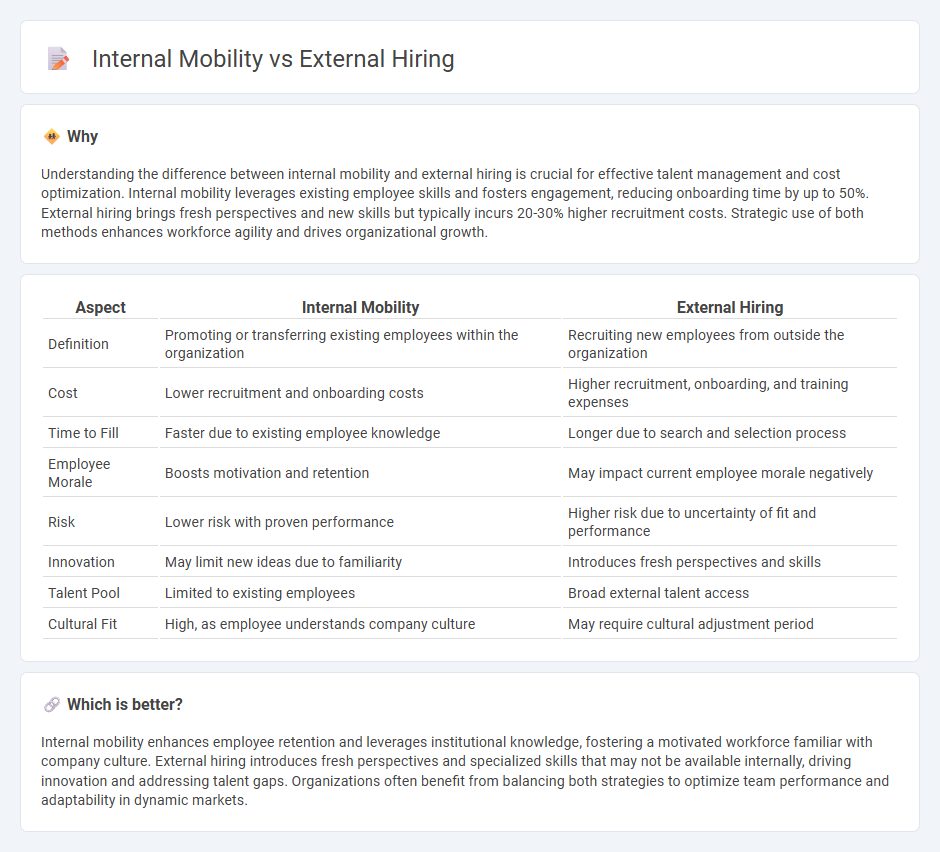
Internal mobility enhances employee engagement and retention by leveraging existing talent with institutional knowledge, reducing onboarding time and costs. External hiring introduces fresh perspectives and specialized skills that may be unavailable within the organization, fostering innovation and diversity. Explore more insights on optimizing workforce strategies through internal mobility and external recruitment.
Why it is important
Understanding the difference between internal mobility and external hiring is crucial for effective talent management and cost optimization. Internal mobility leverages existing employee skills and fosters engagement, reducing onboarding time by up to 50%. External hiring brings fresh perspectives and new skills but typically incurs 20-30% higher recruitment costs. Strategic use of both methods enhances workforce agility and drives organizational growth.
Comparison Table
| Aspect | Internal Mobility | External Hiring |
|---|---|---|
| Definition | Promoting or transferring existing employees within the organization | Recruiting new employees from outside the organization |
| Cost | Lower recruitment and onboarding costs | Higher recruitment, onboarding, and training expenses |
| Time to Fill | Faster due to existing employee knowledge | Longer due to search and selection process |
| Employee Morale | Boosts motivation and retention | May impact current employee morale negatively |
| Risk | Lower risk with proven performance | Higher risk due to uncertainty of fit and performance |
| Innovation | May limit new ideas due to familiarity | Introduces fresh perspectives and skills |
| Talent Pool | Limited to existing employees | Broad external talent access |
| Cultural Fit | High, as employee understands company culture | May require cultural adjustment period |
Which is better?
Internal mobility enhances employee retention and leverages institutional knowledge, fostering a motivated workforce familiar with company culture. External hiring introduces fresh perspectives and specialized skills that may not be available internally, driving innovation and addressing talent gaps. Organizations often benefit from balancing both strategies to optimize team performance and adaptability in dynamic markets.
Connection
Internal mobility enhances employee retention by leveraging existing talent and promoting career development, while external hiring introduces fresh skills and perspectives vital for organizational innovation. Both strategies are interconnected through workforce planning, balancing internal growth opportunities with the infusion of new expertise to meet evolving business demands. Effective management integrates these approaches to optimize talent acquisition and maintain a dynamic, adaptable workforce.
Key Terms
Talent Acquisition
External hiring introduces diverse skill sets and fresh perspectives that can drive innovation and growth within organizations. Internal mobility leverages existing employee knowledge and culture fit, enhancing retention and career development. Explore more about how talent acquisition strategies balance these approaches for optimal workforce planning.
Succession Planning
Succession planning thrives on balancing external hiring and internal mobility to ensure leadership continuity and organizational agility. External hiring introduces fresh perspectives and specific expertise, while internal mobility leverages existing talent's institutional knowledge and fosters employee development. Explore effective strategies to integrate both approaches for robust succession planning.
Employee Retention
Internal mobility boosts employee retention by offering career growth opportunities and reducing turnover rates, as employees feel valued and motivated within the organization. External hiring can introduce fresh skills and perspectives but often involves higher recruitment costs and longer onboarding times, potentially impacting retention negatively. Discover more strategies to enhance employee retention through balanced talent management approaches.
Source and External Links
The Pros and Cons of Internal Hiring vs. External Hiring - This article discusses the advantages and disadvantages of external hiring, including access to a broader talent pool, introduction of fresh perspectives, and specialized skills.
Internal vs. external recruitment: pros, cons, and methods - This piece explores the methods and benefits of external recruitment, including job postings, recruitment agencies, and the impact on company growth.
What is External Recruiting and how does it benefit a company? - This article highlights the benefits of external recruiting, such as promoting healthy competition and enhancing the employer brand, while also discussing ways to improve the process.
 dowidth.com
dowidth.com